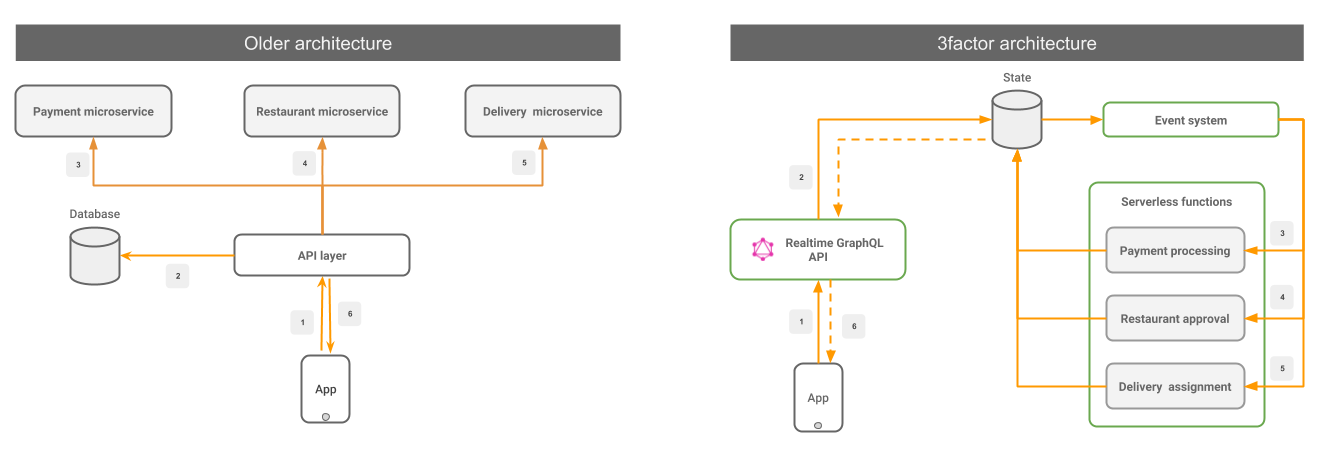3factor
Today, it is possible to build backends for apps that allow for fast iteration, while being resilient and highly scalable from the get go.
The backend architecture for such apps can use the best of the ecosystem today to achieve this. Specifically, the following 3 factors*:
- Realtime GraphQL
- Event-driven
- Async serverless
* Inspired of course, by the 12factors that the Heroku folks put together 7 years ago.
Here's a comparison of a food-delivery application's traditional architecture with a 3factor one:
Realtime GraphQL: Iterate faster on your frontend
GraphQL APIs result in a much faster front-end developer workflow. In addition to speaking GraphQL, your API should also support the following 2 properties:
- Low-latency: An end-user should see instant feedback of an action and not have to wait on an API (<100ms ideal, upto 1 second at worst).
- Support GraphQL subscriptions: Consuming information asynchronously from the backend i.e a “realtime” GraphQL API.
Refactor high-latency synchronous API responses to be reactive instead.
Example:
Instead of REST APIs, use GraphQL as much as possible to improve frontend app development. Further, consider a naive GraphQL mutation to place an order that would have executed a workflow or orchestrated microservices and hence taken a longer time to respond. Refactor this to an “atomic” GraphQL mutation that “places” an order and responds with an “order-id”. Update UI based on realtime workflow updates to the order-id, that the end-user can consume, confident that the order is placed and does not need their attention.
Event-driven: Make your backend resilient
Remove workflow and orchestration state from your backend APIs and persist them into events. Your event system should have 2 properties:
- Atomic: Changes to the backend datastore, via GraphQL mutations or otherwise should atomically emit events so that there is a guarantee that events are always created.
- Reliable: Events once emitted should be delivered atleast once
Example:
Instead of writing an “place order” API endpoint that orchestrates upstream microservices by making API calls to them in a workflow, emit events that capture the state machine. Your event system should deliver the events reliably to other microservices. This makes your application resilient to transient failures because the retry/failure logic is captured in the event system. It makes your application resilient to larger scale failures because the event-system and your data store can easily be replicated across availability zones making application recovery straightforward.
Async serverless: Scale your backend infinitely
Write business logic with serverless compute that is asynchronously triggered. This also mitigates the cold-start issue from causing slower perceived latency.
- Prepare for atleast-once: Your serverless business logic that is triggered by events might get triggered more than once. Try to write your code in a way where it doesn't matter if it is triggered multiple times (idempotent) or add relevant checks.
- Modify state & trigger events: Your logic might cause a change in application state and trigger more events
- Communicate asynchronously to the end-user app via changes in application state that clients can consume via GraphQL subscriptions
This also allows for rapid iteration in the business logic without impacting the GraphQL contract.
Example:
In your food ordering workflow, instead of writing a payment processing microservice that captures different failure modes, write a payment processing function that processes a payment or fails. The event system should capture the retry or failure handling logic so that your business logic is simple and easy to scale.
A 3factor app requires you to remove state from your code and put it in your datastore and in your event queues. Cloud vendors make it easy to scale and replicate your datastore and event-queues. Making your business logic asynchronous requires a proportional investment in your realtime GraphQL API to allow the end-user app to consume asynchronous information easily.
An interesting sidenote: A 3factor app is analogous to the redux dataflow model on a react app, but applied to the fullstack.
